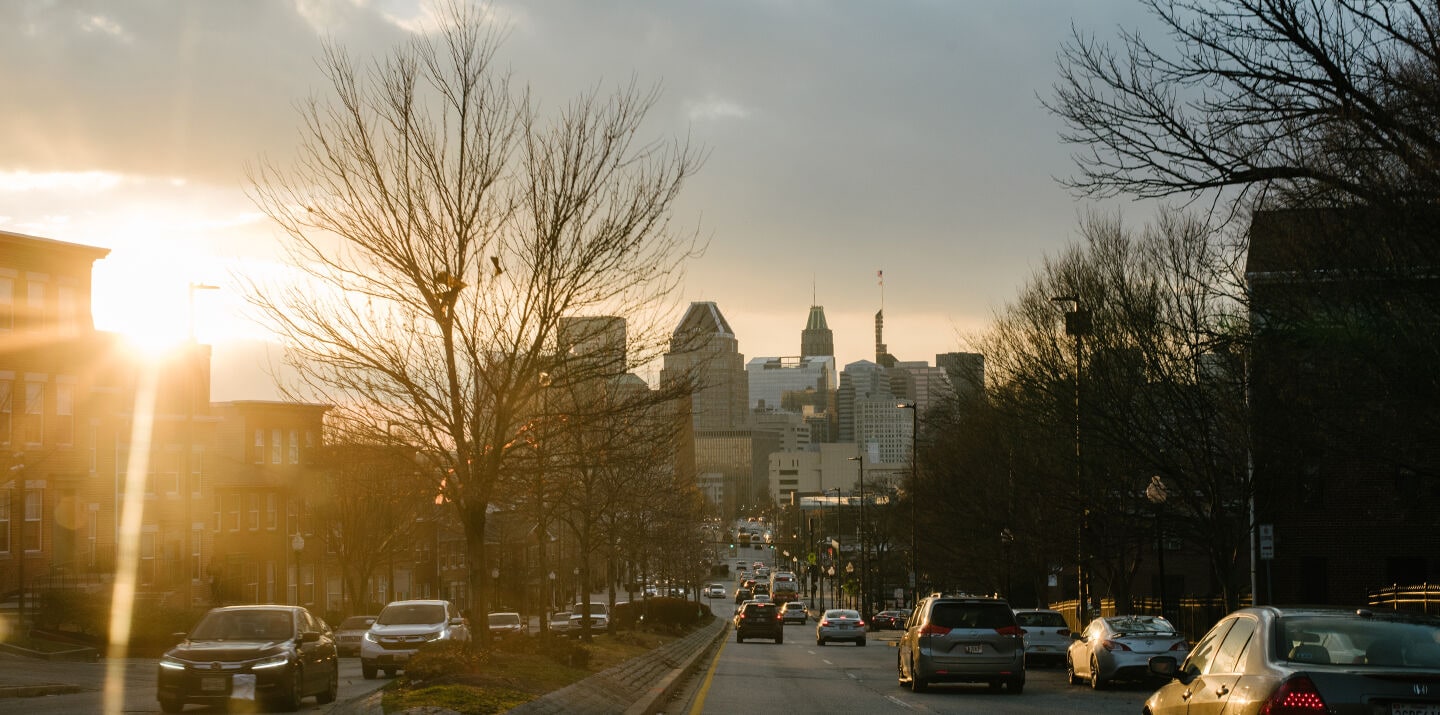
Undefeated: Inside Five Baltimore Turnaround Schools that Refuse to Fail
A promising Charm City collaboration is founded on a stubborn refusal to give up on the notion of a great neighborhood school. No one has said the job is done, but neither are its leaders short on endurance.
In 2010, early on in the Obama administration’s massive effort to invest in the country’s lowest-performing schools, a resident fellow at the American Enterprise Institute published an essay titled “The Turnaround Fallacy.” In it, the author, Andy Smarick, called on decades of research to argue that district-led efforts to turn around persistently failing schools had shown such poor results that they were not worth continued investment.
Smarick’s piece came out a year after Congress had approved $3 billion for turnaround-focused School Improvement Grants, or SIGs, as part of the economic stimulus package. States scrambled for the cash, identifying their lowest-performing 5% of schools and granting districts hundreds of thousands of dollars in exchange for interventions that included wholesale shifts in instruction and staffing.
Then in 2017, the turnaround pessimists pointed to new evidence to bolster their case when the U.S. Department of Education issued an evaluation that found that “implementing any SIG-funded model had no significant impacts on math or reading test scores, high school graduation, or college enrollment.” (Since its release, some researchers have questioned the validity of those results.)
Not far away, in Baltimore, Marc Martin (Baltimore ’98) was in his seventh year as principal of Commodore John Rodgers Elementary/Middle School. Martin had been principal since the school went into turnaround in 2010, the same year “The Turnaround Fallacy” was published.
Even then, he didn’t buy the argument that persistently failing schools couldn’t improve. He didn’t buy it when the SIG evaluation was published. And as the leader of an effort to turn around five schools in Baltimore today, he still doesn’t buy it.
“You can turn around schools,” says Martin, a willing contrarian. “They can be successful. They are working right now. They are game changing.”

Jump ahead to a crisp morning this past December. At a district high school on Baltimore’s north side called the Academy for College and Career Exploration, or ACCE, four Baltimore City principals and a handful of their fellow administrators assembled around a sunlit conference table. Arriving last, businesslike in a suit and tie, black hair neatly trimmed, Marc Martin sat at the head.
Except for Martin, each of the principals (plus one who was absent for a state officials site visit) leads a Baltimore City school in its third year of SIG-funded turnaround. (Martin’s school, Commodore, officially exited turnaround in 2015.) Together, they comprise the leaders of a school district experiment called The 100% Project.
The project—think of it as an in-district network of turnaround schools—is Martin’s brainchild. After Commodore righted the ship, Martin says he became frustrated with district leaders hiring turnaround consultants who lacked the proven experience of school leaders. So in 2016, he called the superintendent and suggested a different option. Let him lead.
He proposed forming a network of four schools that were new to turnaround plus his school, Commodore. Commodore would be the guidepost—kind of the big sibling school who’d been through it. Martin would mentor the other principals, and the staffs of each school would work closely together as they evolved into sustainable school communities year over year—something Martin allows he’s still working on at Commodore. It’s “not a short game,” he says.
The 100% Project is founded on one foundational belief: Turning around a neighborhood school while keeping it in-district and open to every kid is not only possible but an obligation to families and communities. Martin’s bet is that the formidable work of improving an extremely low-performing school is more likely to succeed if teachers and leaders act together in a big but tight team. So that’s how he designed it, with the superintendent’s blessing. So far, he says, it’s working.
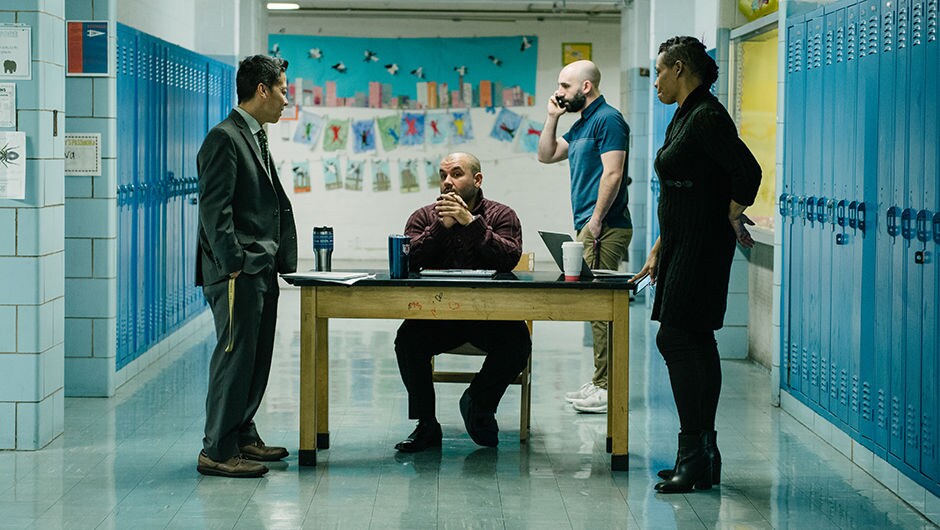
The 100% Project Setup
Five schools make up the cohort: Commodore, ACCE, Harford Heights Elementary, James McHenry Elementary/Middle, and Mary E. Rodman Elementary. The principals meet up at their schools at least twice each month, where the host principal lays out his or her challenges of the moment. Then they break to observe classrooms before coming back together to discuss strategies and solutions. Martin doesn’t supervise the other principals in an official sense. They relate as peers and partners who can take each other’s calls when things go south..
Dave Guzman is the principal of Rodman Elementary, where 23% of students passed the state math assessment in 2018, up from 2% prior to turnaround, and 22% passed the ELA assessment, up from 5%. One of Martin’s goals in working with Guzman, he says, is ensuring those gains are not just a blip, but a foundation to build on each year.
Guzman has been a teacher and principal in Baltimore for 10 years, but a New York City upbringing emerges in his accent. “I’m not trying to be a commercial for The 100% Project,” he says. “But it’s added years to my life as a principal.” Days before the meeting at ACCE, Guzman learned that a Rodman parent had been accused of attacking her child’s school bus driver. He had a stack of complaints on his desk and was ready to ban the parent from the bus stop to avoid an extended battle with the bus company. But instead, Guzman called Chris Turk (Baltimore ’07), the principal at James McHenry, who talked him through possible resolutions. It was one call on a day with a thousand other priorities, but it helped to clear a path. “I wouldn’t want to be a principal any other way,” Guzman says.
Teachers at 100% Project schools to earn slightly more than most district teachers in return for working a slightly longer school year. The extra time, paid for by SIG funds, allows for shared professional development and planning time. (Commodore, the only school in the cohort not to receive SIG funds, pays its teachers a stipend to support their work with 100% Project schools.)
The five schools aren’t trying to fit one mold. They couldn’t—their needs, sizes, budgets, and communities vary significantly. But teachers across the cohort share lesson plans. They’re encouraged to shadow each other to give feedback and pick up best practices. One administrator, Paul Larcom (Baltimore ’11), oversees the project’s professional development— focused this year on academic interventions and the schools’ shared social-emotional learning program, called Capturing Kids’ Hearts—as well as staff collaboration. Larcom acts as the project’s human database of which teachers are doing what, who needs what, and who’s good at what.
Martin played a key role in hiring the principals, each of whom had led other Baltimore City schools to impressive results. In turn, the principals hired every member of their teaching and administrative staffs.
The practice of hiring new staff to turn around schools, sometimes called zero-basing, has ardent detractors who believe it punishes teachers for systemic problems and creates instability in school communities. But Martin is unapologetic. Take away turnaround principals’ power to hire their staff, he believes, and you take away the most critical lever they have to make change. “This work is not for everyone,” Martin says.
Some principals, like Nick D’Ambrosio at ACCE, retained about 25% of the school’s pre-turnaround teachers. Others, like Guzman, hired back only one teacher.
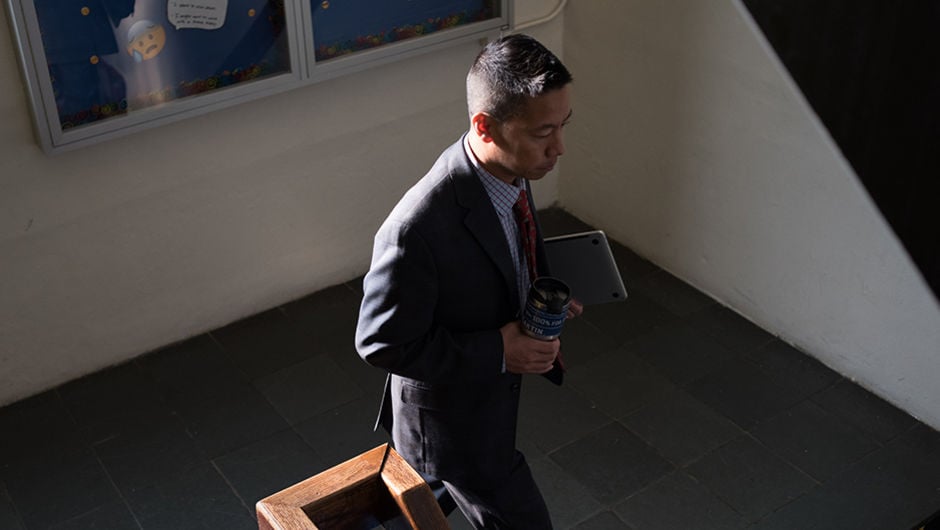
The Turnaround Veteran
Based in part on its dismal test scores, Commodore ranked 872 out of 875 schools in Maryland when Martin was hired to lead it in 2010. At that point, the school enrolled 250 students, barely viable in a building built for more than 600.
Today, in a district grappling with steep enrollment declines overall, Commodore squeezes in more than 900 students (including Martin’s three kids), almost all of them from the neighborhood. They crowd into classrooms and spill into meeting rooms. They collaborate on clusters of chairs pulled into alcoves under the stairways. Not a minute too soon, renovations and expansions are planned for completion in 2021.
In October, Commodore was recognized for excellence by the Baltimore City school board. Over four years, 37% of its students who initially tested at the lowest level of proficiency moved up to one of the high levels, compared to 14% of similar students districtwide. In 2019, the school earned Maryland’s three-star rating (out of five), up from two stars in 2018. The improvement reflects factors like Commodore’s high attendance rate and parent satisfaction, as well as student test scores, which consistently meet or exceed Baltimore City averages. (The state no longer ranks schools numerically from best to worst.)
Martin says flatly that meeting Baltimore City’s average is nowhere near good enough. But still, it represents a steady path of progress from the bottom ranks. And improvements haven’t come at the expense of the student experience: Commodore kids participate in robotics, student government, band, orchestra, choir, and sports teams, among other electives and extracurricular options. Parents trust in the school’s direction. They’ve shown it by filling up the school roster to the extent that Commodore has had to limit the enrollment of students from outside its neighborhood zone. That, Martin says, is a significant proof of concept.
John Davis (Baltimore ’92) is the Baltimore City Public Schools’ chief of schools. He defends the 100% Project approach, even as student outcomes are not yet where leaders want them to be. “When you ensure a school has a strong leader, a collaborative teaching environment, and a vibrant culture for students and families, it’s not just a legitimate path, but one that has shown consistent results across the nation,” Davis says. “As we combine promising models like the 100% Project with district-led curriculum reform, student outcomes will continue to grow at those schools.”
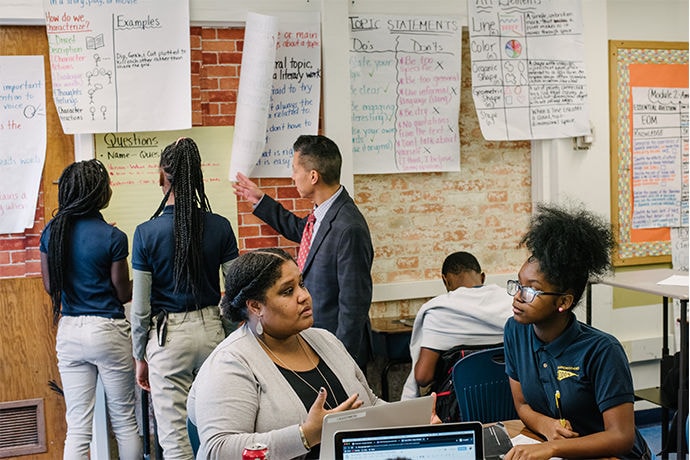
If Commodore is held up as a district exemplar, Martin takes his school’s gains as encouraging indicators more than wins. Teachers ding him for failing to stop and celebrate the consistent growth. But for Martin, improvements mean his teachers are doing the job he hired them to do—and the job’s not done.
He expects a workhorse ethic, but he abides by it, too. Before beginning his first year as an eighth grade social studies teacher at Baltimore’s Fallstaff Middle School, in the fall of 1998, Martin and two fellow corps members made a pact that they’d get through the school year without taking a single day off. One friend was out of the running by Thanksgiving. The other lasted into his second year of teaching, when he developed pneumonia, began hallucinating, and was sent home by his principal.
Martin’s streak ended only in November, when a regrettable dive during a paintball battle at his son’s 13th birthday party led to emergency spinal surgery and three days bedrest, doctor’s orders. For more than 21 years, through bugs and viruses, a super-strain of the flu that required him to walk to a nearby hospital after morning announcements, and the birth of his three children, he didn’t miss a single day of school. (Two of his kids were born on weekends, and the third was born “late enough in the day that Marc was able to make an appearance,” says his wife, Baltimore ’01 alumna Kate Martin.)
Setting aside how prudent this is, Martin’s streak reveals something fundamental: He likes a goal and won’t stop till he meets it. (He and Kate have found ways to maximize this at home where he does check-off chores, like dishes and laundry, while she takes on tasks that require flexibility, like doctor appointments and camp registrations.) Martin’s approach is unconventional, maybe even ill-advised. And observers have used it to pass off Commodore’s growth as an anomaly—the result of a unicorn leader. The 100% Project is Martin’s attempt to prove otherwise.
Turnaround schools don’t need someone just like him, Martin says. They need a defensible vision and a school community that can execute aligned efforts to an exceedingly high standard. If schools have that, they can make dramatic improvements in a few years’ time and regain a community’s trust in sustained progress over the long haul. It’s important not to call it magic, Martin says, because policy leaders don’t invest in magic. “And this,” he argues, “is where the investment should be.”
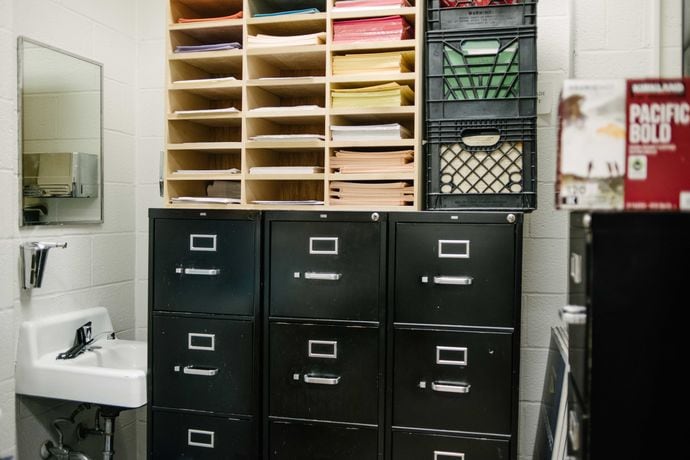
What it Takes Part 1:
A High Bar for More Than Academics
Josh Bailey (Baltimore ’11) is the principal at Baltimore’s Windsor Hills Elementary. During the 2016-17 school year, a planning year for The 100% Project, he was Martin’s resident principal at Commodore. To this day, Bailey lists Martin as his emergency contact, just behind Bailey’s wife (a fact that came as a surprise to Martin). “If my house was burning down, Marc would know what to do,” Bailey says.
When Bailey was at Commodore, other aspiring principals would ask, “’How do you do this? What’s the secret sauce?’” Bailey says. But they’d be frustrated, “because it’s an unsatisfying answer. It has to boil down to mission and vision. What you say you’re going to do, and not do, has to be pushed forward.”
The 100% Project schools hold college readiness as their vision for all students, which shows up in innumerable ways. Every teacher hosts afterschool academic coaching, for example, and students can be required to attend. Kids lead their own parent-teacher conferences. The schools’ instructional leadership team meetings—teacher leaders from different grade levels and subject areas—make the Joint Chiefs of Staff look like amateurs. Set the bar too low, Martin says, and you won’t turn around a low-performing school.
The schools also adhere to the same set of values, called “five promises,” that Martin brought to Commodore from his previous role leading Crossroads, a Baltimore charter school. They are commitment to quality, honor and integrity, perseverance, contribution, and gratitude. At weekly grade-level meetings, students are called out for exemplifying each promise and awarded brightly colored bracelets, which they wear with pride.
Gratitude replaced “no excuses” soon before the launch of The 100% Project. Moving away from “no excuses” was a journey for Martin, who came up as a teacher and principal in an era when the phrase was a school leader’s pledge of allegiance to do whatever it takes to help students succeed. But by the mid-2010s, the “no excuses” approach had led to some schools instilling overly rigid school cultures, and the mantra had come to be interpreted as a demand on students more than on educators.
“As we were planning for The 100% Project, we talked a lot about what a student-centered mindset meant,” Martin says. He thought about his own kids—now in seventh, sixth, and first grade at Commodore—and his dreams for their school experience. “Every time we studied it, we came back to the idea that ‘no excuses’ doesn’t allow students to be who they are.”
The shift to “gratitude,” Martin says, has encouraged students to recognize the good around them—in themselves, each other, their teachers, and their community. “It’s created an environment that is more joyful, where there’s more engagement in our shared work.”

What it Takes Part 2:
Families as Partners
At James McHenry Elementary/Middle School, parent Shannette Jones was fighting for the school to turn around long before Principal Chris Turk was hired through The 100% Project. Jones had grown up a few blocks from McHenry and attended the school through fifth grade. She went on to graduate from high school and become a pharmacy technician. In 2010, when it was time for pre-K, she sent her son, Tyrone, to McHenry—it was the obvious choice.
But by Tyrone’s first grade year, Jones worried about a lack of stability at the school. His class floundered with a string of long-term substitutes, and they weren’t alone. So Jones left full-time pharmacy work to start an event-planning business, opening up time during the school day to volunteer at McHenry.
“I’d go wherever I was needed,” Jones says. She became that parent everyone could count on. When kids came to school in dirty uniforms, she’d reach out to their families and let them wash their clothes in the school’s washer/dryer. When she ran the school’s Friday food pantry, she called down kids whose families were most in need and gave them first pick, making sure they got milk to go with their cereal. She cleaned bathrooms, monitored hallways, greeted parents. One morning, a mother confided in Jones that her child’s father was abusive. Jones called a local women’s shelter, and they picked up the mother and child that day.
Midway through the 2013-14 school year, McHenry brought in its third principal in three years. The frequent turnover sank teacher morale—it seemed every week another teacher quit and another classroom had an unprepared substitute. At one point, the school offered Jones a stipend to help out in one classroom. She turned it down. “This school needed so much more than that,” she says.
The new principal came in hard, Jones says. He put up a fence around McHenry’s perimeter; he made stringent demands of even the youngest kids. “But these were still children. And these families—they didn’t do anything wrong,” she says. “It was like, ‘This is not a jail.’”
Heartbroken, Jones took her kids out of McHenry and enrolled them at George Washington Elementary in the fall of 2014. She introduced herself to the principal, a serious young man with a wrestler’s slight build and a neatly kept black beard. “I’d like to help,” she said. Chris Turk welcomed her aboard.
In spring 2017, Turk was hired to turn around McHenry as part of The 100% Project. He called Jones and asked if she’d consider coming with him and re-enrolling Tyrone, who would enter sixth grade in the fall (while her daughter Aamaiah would enter third). “I told him, ‘Mr. Turk, I don’t know. I don’t have any more energy for James McHenry,” Jones recalls. But Turk promised her that it would be different—not just for kids, but for parents. And he needed her help to earn back their trust.
Martin says Turk’s superpower—and sometimes his Achilles’ heel—is his passion, his intensity. “He knows how to rally his staff,” Martin says. “He has the ability to bring his team together, get them excited, feel like they’re doing something special.” That energy, along with boots-on-the-ground work to greet neighbors and invite them back, has attracted families who had all but given up. In little over two years, McHenry has almost doubled its enrollment, from 340 students in 2017 to more than 600 today.
Jones, now the president of the school’s parent-teacher organization, is back in her habit of showing up at McHenry each day. “I thought Turk was going to fold the first year,” she says. “But I’m telling you, it is transformed.” Kids are engaged and their test scores are rising, but more than that, so are families’ spirits. PTO meetings regularly attract at least 20 parents and often more, and school events pull in nearly 200 people, Jones says. Only a handful of teachers have left since the turnaround, and many more have been hired to serve the growing enrollment. In September, Tyrone’s robotics team won the Samsung Solve for Tomorrow competition, beating out middle and high schools in Maryland and D.C. and netting McHenry a $20,000 prize.
Turk says that involving parents as leaders—a focus of each of the 100% Project schools—helps him to make decisions when he’s pulled in a million directions. When asked how he knows turnaround is working, he points first to parent surveys showing at least 90% satisfaction on measures like “family involvement” and “learning climate.” Collecting parent feedback (whether through surveys or daily conversations and meetings) offers him and all the principals a sort of north star. “Sometimes educators talk about families and what they want. But unintentionally, we’re not asking ‘What do families put as their priority?’ We serve students and families.”
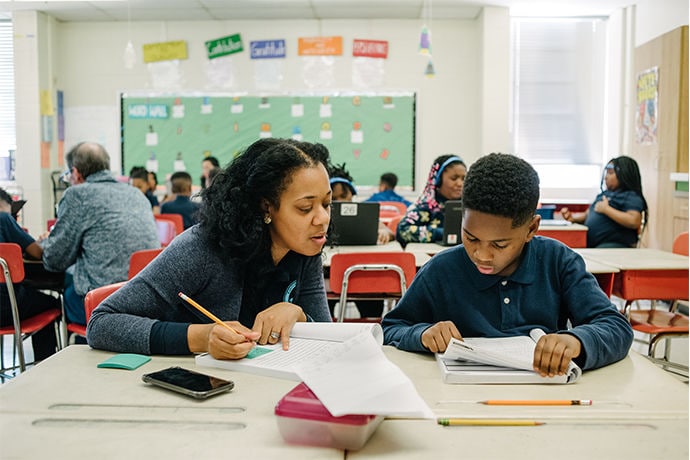
What it Takes Part 3:
Using Data to Drive More Than Academics
Danielle Cromartie, principal of Harford Heights, is the 100% Project principal whom others turn to for her focus on data-driven results. At a November meeting of her instructional leadership team, Cromartie drilled down on the utility of the data the teachers collected. In a language that can only be understood by educators immersed in it, she sought proof that every assessment—whether iReady or ImagineMath or ANet or DIBELS, whether BOY (beginning of year) or EOY (end of year) or one of the countless mid-year measures—provided data that could be used to guide each student’s holistic growth.
In 2018, Harford Heights scored effective or highly effective on 10 out of 11 measures of the district’s “school effectiveness review,” compared to zero in 2015-16.
Tom DeWire, the lone consultant hired by The 100% Project and an expert in using data to inform curricular approaches, meets with each school quarterly to help educators analyze their results and pave the road forward. He followed Cromartie’s every word in an attempt to create a dashboard she could use to track student progress once the SIG money that employs him runs out.
Harford Heights, like Mary E. Rodman, faces a dwindling budget, so Cromartie is nearly as obsessed with data-driven spending as she is with data-driven instruction. First, its SIG funding decreases each year, which is true at each of the schools. But while the neighborhoods served by James McHenry and Commodore are growing, allowing for projected increases to enrollment and larger budgets, the areas around Harford Heights and Rodman are emptying out as families seek job opportunities, amenities like grocery stores and laundromats, and safer housing elsewhere. “We do home visits and find houses boarded up when we know families were there two weeks earlier,” Cromartie says.
“Knowing that each year funding is decreasing, it gives me heart palpitations because it means that next year, something we have now is going to go away,” Cromartie says. So she’s planning now for leaner days to come. Instead of hiring leaders outside the school to run professional development, she’s tapping her own teachers with the hope that they’ll be seen as the experts, instead. In anticipation of funding running dry for the school’s partnership with a nonprofit focused on wellness practices in underserved communities, she’s ensuring that all classroom teachers are trained in leading mindfulness exercises.
Martin says Cromartie’s thoughtfulness around planning and budget is instructive for each of the principals in The 100% Project, and it comes through in their meetings as budget cuts loom. “She’s really the best at that of any of us,” he says.
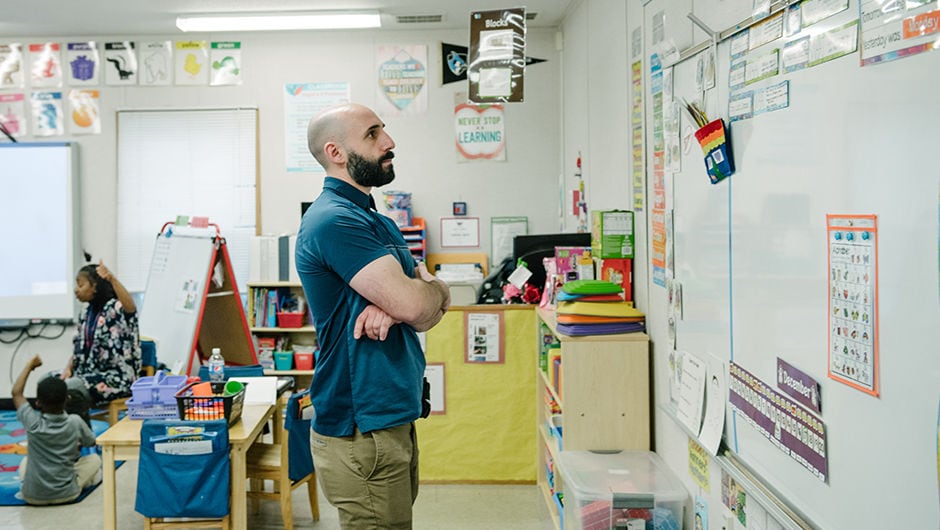
What it Takes Part 4:
Stay Focused
The 100% Project schools operate as their own network, but all staff are district employees responsible for district initiatives. Martin often acts as the schools’ liaison with leadership and helps the principals navigate what’s necessary to stay in line with requirements.
In 2018, for the first time, Baltimore City Public Schools hired a director of race and equity, brought on to tackle glaring disparities like the fact that the gap between proficiency rates for white and Black students on state exams consistently sits at about 30 percentage points.
“Symbolically, I love it,” Martin says, referring to the new district-level role. But he believes now it’s up to the district—not principals whose expertise is in the day-to-day work of running schools—to develop in-depth programming for staff. “I refuse to do a ‘cross-the-line’ activity and pretend we’ve addressed race and equity,” he says, referring to a popular activity designed to bring awareness to privilege.
Martin tries to impart that being a turnaround principal is about adhering single-mindedly to a specific and limited set of priorities that you are certain can be accomplished, like creating a space where students are safe and welcomed, and introducing opportunities to engage kids’ intelligence and creativity.
“I don’t want anyone to be confused: The work we are doing is all about race and equity,” Martin says. “Whether it’s meeting with families in their homes, accepting responsibility and apologizing when we make mistakes, collaborating with families, setting high expectations, offering diverse programming, making specific choices around our funds and schedule so we’re not just drilling and killing—that’s where our focus has been around race and equity.”
He points as an example to the Ingenuity Project, an application-based middle school STEM magnet program renowned for propelling its graduates into Baltimore’s top-ranked high schools. For 20 years, though technically it was open to students citywide, Ingenuity was housed in three middle schools serving Baltimore’s upper-income neighborhoods. But when the nonprofit program was ready to expand, it solicited applications from schools all over the city.
The application from James McHenry school hit every mark, says Lisette Morris (Baltimore ’97), executive director of the Ingenuity Project. Parents and students, including Shannette Jones and her son, Tyrone, testified to what Ingenuity would mean for McHenry. “There were tears in those focus groups,” Morris says. McHenry won.
In wealthier and typically whiter parts of Baltimore, parents clamor to get their kids into Ingenuity. “The acceptance rate is 30% and parents are freaking out,” Morris says. But when her team recruited from the neighborhoods surrounding McHenry, no one even knew what Ingenuity was. Morris says it drove home for her that “in connected, middle class communities, there’s this unstructured way in which information is shared” about opportunities for kids. But in others, that information never reaches parents.
After months of door-knocking and public meetings, Ingenuity had filled its 50-seat program at McHenry, widening the elite program’s reach significantly. In 2016-17, 38% of Ingenuity students identified as Black or Latinx; today, 56% do. In 2017-18, 20% of Ingenuity students came from low-earning households; today, 39% percent do.
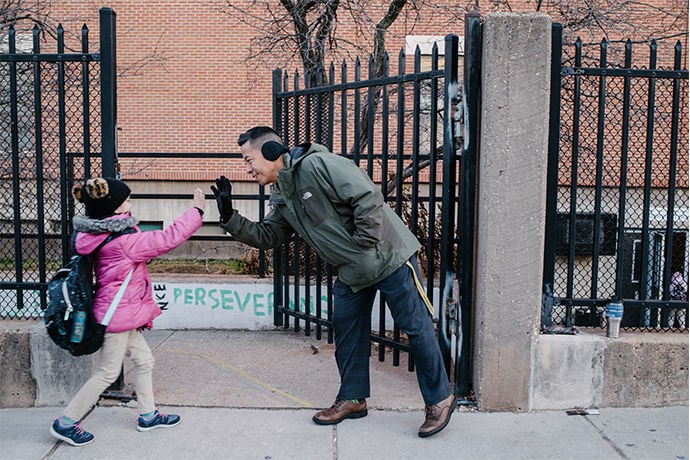
These days, Martin doesn’t spend much time thinking about turnaround naysayers because he believes his school proves them wrong and the other 100% Project schools are well on their way. But he wishes they would think more about him. “I read articles about how we should never invest in failing schools, and it makes my blood boil, because I know it’s possible,” Martin says.
Though his family lives in Baltimore, Martin’s kids play sports in suburban leagues. So he was sitting in the spacious entryway of a suburban Baltimore school, waiting for his daughter’s basketball practice to end, when he took a moment to reflect on this question: Even if schools have the resources, are there are enough committed teachers and leaders to do the work that turnaround requires?
“My argument is that whatever talent there is, the best that there is, the investment should be at schools like ours,” he says. “And the conditions should be set so that talented people should be encouraged to go to these schools, if not forced to go to these schools.
“We’ve been a turnaround school. It’s hard work, and more is required. There are days when it feels like the incentives are stacked against turnaround schools. But even within that system, we’ve found a way to succeed.”
Sign up to receive articles like this in your inbox!
Thanks for signing up!
Content is loading...


